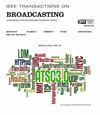Social VR With Holographic Comms: Enablers for New Engaging Experiences Within the TV / Video Consumption Landscape
IF 4.8
1区 计算机科学
Q2 ENGINEERING, ELECTRICAL & ELECTRONIC
引用次数: 0
Abstract
Social Virtual Reality (VR) enables shared media experiences between remote people inside immersive and realistic 3D spaces, providing richer and more natural interactions than in classical 2D social conferencing tools. Likewise, the benefits and engagement can even be magnified by integrating realistic and volumetric user representations (i.e., 3D holograms) in these virtual environments rather than synthetic avatars. This paper presents the design and evaluation of an interactive Social VR scenario for a joint and collaborative exploration of a catalogue of professional video clips by a broadcaster. On the one hand, the scenario includes a control panel to select the desired year and clip. After the year selection, a time travel through a lift effect is enforced to teleport users through a multi-level semi-open building in which each level / floor represents one year, and its look-and-feel is customized to resemble that year. On the other hand, the scenario allows the integration of up to four users represented as 3D holograms (full-body and full volume Point Clouds), each one with his/her own screen for video consumption, and arranged in a cross 360° shape to allow for a natural visual interaction among themselves. The evaluation results with N=48 professionals of the broadcast sector not only provide relevant insights about the technical requirements and obtained performance, but confirm the satisfactory user experience (in terms of presence, togetherness, quality of interaction) provided by the presented technology and VR scenario and, most importantly, reveal and contribute to identifying the potential and opportunities of Social VR in the broadcast / video consumption landscape.带有全息通信的社交VR:电视/视频消费领域中新的引人入胜的体验的推动者
社交虚拟现实(VR)使远程人员能够在沉浸式和逼真的3D空间中共享媒体体验,提供比传统2D社交会议工具更丰富、更自然的交互。同样,通过在这些虚拟环境中集成逼真的和立体的用户表示(即3D全息图),而不是合成的虚拟形象,甚至可以放大这些好处和用户粘性。本文介绍了一个交互式社交VR场景的设计和评估,该场景用于联合和协作探索广播公司的专业视频剪辑目录。一方面,该场景包括一个控制面板,用于选择所需的年份和剪辑。在年份选择之后,通过电梯效果进行时间旅行,将用户传送到多层半开放式建筑中,其中每层/楼层代表一年,其外观和感觉被定制为与该年相似。另一方面,该场景允许将多达四个用户集成为3D全息图(全身和全体积点云),每个用户都有自己的屏幕用于视频消费,并以交叉360°的形状排列,以允许他们之间的自然视觉交互。N=48名广播行业专业人士的评估结果不仅提供了有关技术要求和获得的性能的相关见解,而且证实了所呈现的技术和VR场景提供的令人满意的用户体验(在存在,团聚,交互质量方面),最重要的是,揭示并有助于识别社交VR在广播/视频消费领域的潜力和机会。
本文章由计算机程序翻译,如有差异,请以英文原文为准。
求助全文
约1分钟内获得全文
求助全文
来源期刊

IEEE Transactions on Broadcasting
工程技术-电信学
CiteScore
9.40
自引率
31.10%
发文量
79
审稿时长
6-12 weeks
期刊介绍:
The Society’s Field of Interest is “Devices, equipment, techniques and systems related to broadcast technology, including the production, distribution, transmission, and propagation aspects.” In addition to this formal FOI statement, which is used to provide guidance to the Publications Committee in the selection of content, the AdCom has further resolved that “broadcast systems includes all aspects of transmission, propagation, and reception.”
 求助内容:
求助内容: 应助结果提醒方式:
应助结果提醒方式:


